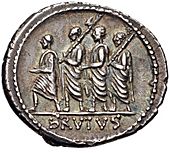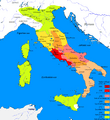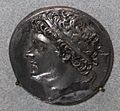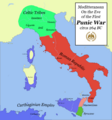Roman Republic facts for kids
Quick facts for kids
Roman Republic
|
|||||||||
|---|---|---|---|---|---|---|---|---|---|
| 509 BC–27 BC | |||||||||
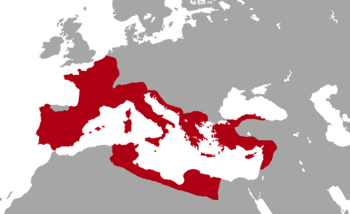
Roman provinces on the eve of the assassination of Julius Caesar, 44 BC
|
|||||||||
| Capital | Rome | ||||||||
| Common languages | Latin (official) Etruscan, Greek (unofficial, but commonly spoken) |
||||||||
| Religion | Roman polytheism | ||||||||
| Government | Constitutional republic | ||||||||
| Consuls | |||||||||
|
• 509–508 BC
|
Lucius Junius Brutus, Lucius Tarquinius Collatinus (first) |
||||||||
|
• 27 BC
|
Gaius Octavianus, Marcus Vipsanius Agrippa (last) |
||||||||
| Legislature | Legislative Assemblies Roman Senate |
||||||||
| Historical era | Classical antiquity | ||||||||
|
• Overthrow of Tarquinius Superbus
|
509 BC | ||||||||
|
• Dissolution of the Latin League
|
338 BC | ||||||||
|
• Caesar proclaimed dictator
|
47 BC | ||||||||
| 2 September 31 BC | |||||||||
| 16 January 27 BC | |||||||||
| Area | |||||||||
| 326 BC | 10,000 km2 (3,900 sq mi) | ||||||||
| 50 BC | 1,950,000 km2 (750,000 sq mi) | ||||||||
|
|||||||||
The Roman Republic was an important time in the history of Ancient Rome. According to legend, the city of Rome was founded by Romulus in 753 BC. Rome was a kingdom until 510 BC. That's when the last King, Lucius Tarquinius Superbus, was overthrown. After this, the Roman Republic began.
The Roman Republic was very well organized for its time. The Roman people elected leaders called Consuls. These consuls ruled for a short period. Many ideas from the Roman Republic are still used in governments today.
Contents
The End of the Republic
Historians disagree on the exact end date of the Roman Republic. Some say it ended when powerful groups of three men, called Triumvirates, gained control.
Julius Caesar and Civil Wars
Many people believe the Republic ended when Gaius Julius Caesar became a dictator (a single ruler). This happened after a series of civil wars. These wars lasted from about 49 BC to 44 BC.
The Rise of Augustus
Another idea is that the Republic ended with the Battle of Actium. This was a big naval battle between Marcus Antonius and Octavian. Both had been part of the Second Triumvirate. Octavian won this battle on September 2, 31 BC. He later became the first Roman Emperor. The Republic could also be seen as ending when Octavian was given the special title of Augustus. This happened on January 16, 27 BC.
Even though modern historians see the Republic as ending, the early emperors had a different view. They said the res publica (which means "Republic") still existed. They claimed it was just "under their protection." They even promised it might return to its original form one day, though this never happened. After the Roman Republic ended, the Roman Empire began.
Roman Power and Challenges
The Republic became wealthy mainly through trading and taxation. It faced some tough enemies during its time.
Wars with Gauls and Carthaginians
The Romans were often at war with the Gauls. These were tribes from areas like modern France. Julius Caesar later conquered them. The Punic Wars were major conflicts against Carthage. These wars were fought around the Mediterranean Sea, mostly over control of Sicily and trade routes.
Other Threats
Another enemy was the Germanic tribes. Romans often called them barbarians, meaning "uncivilized people." The Republic also faced internal problems. For example, Spartacus led a large slave revolt. He even defeated a Roman consul's army before being captured. The Republic also suffered greatly from Hannibal. He was a Carthaginian general who crossed the Alps with his army. Hannibal defeated the Roman army in many battles, including at Cannae. This made Rome fear it would be destroyed.
Images for kids
-
Map showing Roman expansion in Italy.
-
The Temple of Hercules Victor, Rome, built in the mid 2nd century BC, most likely by Lucius Mummius Achaicus, who won the Achaean War.
-
Bust of Pyrrhus, found in the Villa of the Papyri at Herculaneum, now in the Naples Archaeological Museum. Pyrrhus was a brave and chivalrous general who fascinated the Romans, explaining his presence in a Roman house.
-
Coin of Hiero II of Syracuse.
-
Denarius of C. Caecilius Metellus Caprarius, 125 BC. The reverse depicts the triumph of his great-grandfather Lucius, with the elephants he had captured at Panormos. The elephant had thence become the emblem of the powerful Caecilii Metelli.
-
A Carthaginian quarter shekel, perhaps minted in Spain. The obverse may depict Hannibal under the traits of young Melqart. The reverse features one of his famous war elephants.
-
Roman marble bust of Scipio Africanus, found in the Tomb of the Scipios.
-
Bust, traditionally identified as Gaius Marius, instigator of the Marian reforms.
-
A Roman marble head of Pompey (now in the Ny Carlsberg Glyptotek).
-
The Tusculum portrait, a Roman sculpture of Julius Caesar, Archaeological Museum of Turin, Italy
-
The Curia Julia, the senate house started by Julius Caesar in 44 BC and completed by Octavian in 29 BC, replacing the Curia Cornelia as the meeting place of the Senate.
-
The Roman Forum, the commercial, cultural, religious, and political center of the city and the Republic which housed the various offices and meeting places of the government
-
Detail from the Ahenobarbus relief showing (centre-right) two Roman foot-soldiers c. 122 BC. Note the Montefortino-style helmets with horsehair plume, chain mail cuirasses with shoulder reinforcement, oval shields with calfskin covers, gladius and pilum.
-
Roman warrior, fresco in Pompeii, ca. 80—20 BC
-
A Roman naval bireme depicted in a relief from the Temple of Fortuna Primigenia in Praeneste, c. 120 BC; now in the Museo Pio-Clementino in the Vatican Museums
-
Temple of Janus as seen in the present church of San Nicola in Carcere, in the Forum Holitorium of Rome, Italy, dedicated by Gaius Duilius after his naval victory at the Battle of Mylae in 260 BC
-
The "Togatus Barberini", depicting a Roman senator holding the imagines (effigies) of deceased ancestors in his hands; marble, late 1st century BC; head (not belonging): mid 1st century BC
-
Ruins of the Aqua Anio Vetus, a Roman aqueduct built in 272 BC
-
The tomb of the Flavii, a necropolis outside the Nucerian gate (Porta Nocera) of Pompeii, Italy, constructed 50–30 BC
-
Inside the "Temple of Mercury" at Baiae, a swimming pool for a Roman bath, built during the late Roman Republic, and containing one of the largest domes in the world before the building of the Pantheon
-
The Orator, c. 100 BC, an Etrusco-Roman statue of a Republican senator, wearing toga praetexta and senatorial shoes; compared to the voluminous, costly, impractical togas of the Imperial era, the Republican-era type is frugal and "skimpy" (exigua).
-
The Amphitheatre of Pompeii, built around 70 BC and buried by the eruption of Mount Vesuvius 79 AD, once hosted spectacles with gladiators.
See also
 In Spanish: República romana para niños
In Spanish: República romana para niños


